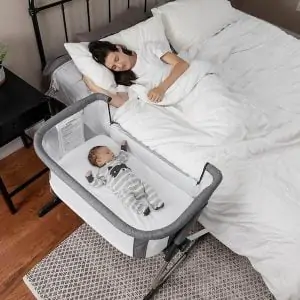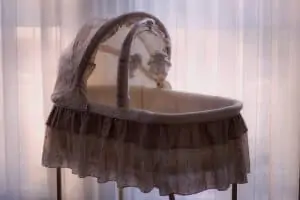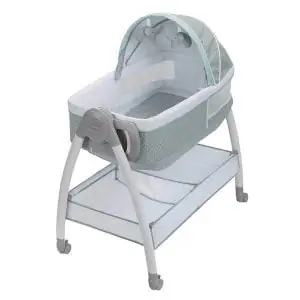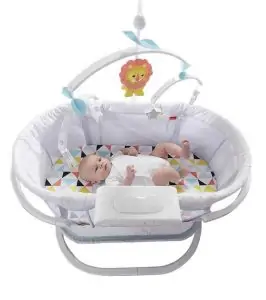Are you debating between a bassinet and a crib, but can’t figure out which one is the best choice for your baby? This debate is something that parents have to debate all of the time; safety is crucial. Safe sleep is at the top of the list for keeping your baby safe, so arguing bassinet vs. crib is an obvious problem.
Here’s the deal:
To help you make a decision, we are going to take an in-depth look at both cribs and bassinets. We’ll cover the everyday worries and questions, so let’s get started.
Bassinet vs. Crib: The Differences and Similarities
Before we take a look, remember that both of these are a safe choice. The CPSC certifies that both cribs and bassinets are acceptable choices for your child, so long as you follow safety rules.
Bassinets: The Details
A bassinet is a bed for new infants between birth and four months old. Some can be used until six months old. They can be oval or square-shaped with mesh sides, ideally, and easy mobility.
The idea behind bassinets is that you and your baby need and want to be close together after birth. Babies want to be near their mother; it’s only natural. A bassinet can be attached to the side of your bed or be close beside but not connected.
Many bassinets have bases that raise and lower it to match your bed’s height. That lets you see your baby quickly in the middle of the night. All parents know that sheer panic that happens in the middle of the night when you worry that something is wrong with your baby. 🙁
You can buy bassinets in a variety of colors, shapes, decor, and more. Some have metal stands, and others use wood. Some have a ruffled, classic design, while others have a modern, sleek look. Manufacturers today have added lights, sounds, and even rocking movement powered by batteries!
Co-Sleepers vs. Bassinets
Are you wondering if there is a difference between co-sleepers vs. bassinets?
Co-sleepers are a type of bassinet, but they’re still a bassinet regardless. They’re the type of bassinet that attaches to the side of your bed, keeping your baby right beside you yet on a separate, safe surface. This is the most reliable way to co-sleep with your baby.
Co-sleepers have a side that folds down, letting you have easier access to your baby. You also can roll up the sides if you don’t want to attach the sleeper to your bed.
Reasons Why You Would Want a Bassinet
Now that you know what a bassinet is, you might be wondering what the pros and cons of a bassinet. There are some areas in which a bassinet excels over a crib.
Here are some bassinet pros.
- They’re the perfect size for your newborn baby who is used to sleeping in a cozy womb rather than a wide, open crib.
- Most have wheels that allow you to move the bassinet around as needed throughout your room or house.
- They’re MUCH lighter than a crib; you can easily pick them up.
- If you want to room share or co-sleep, a bassinet is an ideal choice because they can roll up and attach to the side of your bed easily.
- Have a small bedroom? Don’t fret; bassinets are space-saving!
- Let’s not forget that a bassinet is a fraction of the price of a crib.
- Some bassinets are designed to be portable, so you can fold it up and take it while on the go.
- They are affordable! Since they are made with lighter materials, the cost tends to be lower.
Reasons Against Bassinets
Those are some impressive baby bassinet pros, but like everything else, they also have cons. Here are the bassinet cons.
- You only can use them for a few months! Between four to six months old, you have to stop using them. For some, you need to stop using them as soon as your baby rolls over, and that might be as early as eight weeks.
- Because they have a higher center of gravity, they are easier to tip over than cribs.
Some babies do hate bassinets and here is what you can do.
Cribs: The Details

Most people are familiar with what a crib is. While they do differ in size and materials, a crib always looks like a crib. By definition, cribs are a small child’s bed with high, enclosing, slatted sides. Manufacturers follow strict regulations to be sure that all cribs pass safety regulations to keep your baby safe while sleeping.
You can find a few variations of cribs, such as:
Traditional Cribs
These are the traditional, rectangular-shaped cribs. They are simple and effective, as well as being easy to put together. That’s always a plus.
Mini Cribs
If you don’t have a lot of space, a mini crib could be a better choice for you. They’re half the size of a traditional crib with mattresses measuring 24 inches wide and 38 inches long.
Convertible Cribs
These are similar to traditional cribs; they’re the same size. The main difference is that you can later convert these cribs into a toddler bed, daybed, or even a full-size bed. It can be a fantastic investment for a family.
Cradles
You might be wondering around bassinets vs. cradles. Cradles are smaller than cribs but larger than bassinets. They typically have a rocking base that lets you rock your baby into comfort. Cradles were once very popular, but since they aren’t made as often anymore, they aren’t the top pick for parents anymore.
Reasons Why You Want a Crib
So, what are the crib pros? There are many reasons why parents want cribs; they’ve been used for decades. Remember, you WILL need a crib once your child transitions out of a bassinet, but we are looking at the pros and cons of starting with a crib as soon as your baby is born.
- A crib has a stable design with a reduced risk of tipping over. They do weigh more, which is one of the reasons why you don’t need to worry that your toddler will pull the crib over, trying to sneak a peek at his new sibling.
- Cribs are investments that last for years to come! They can be handed down to each child and used longer than a bassinet.
- You don’t need to switch sleeping areas! Your baby can sleep in a crib from birth until your child transitions to a toddler bed.
- Cribs come in a variety of styles, colors, and decors.
Reasons Against Cribs
Those are some great reasons to pick a crib, but here are some bassinet cons.
- They’re heavy! While that does help to reduce tipping, it means that moving it around can be a bit tricky at times.
- If you have a smaller sized room, it might not fit in your bedroom along with your bed.
- If you want to room share or co-sleep, using a crib makes that much harder. While you can sidecar cribs, it’s harder than using a bassinet.
- It’s harder to put cribs together than a bassinet. It’s a more complicated assembly.
What About a Pack ‘n Play?
You might be debating a pack ‘n play instead of a crib or a bassinet. Many come with a bassinet top that lets your new baby sleep on top, then you can move them down to the regular part when he’s too big.
For newborn babies and younger infants, a pack ‘n play can be a great choice, and they are safe for sleep. The problem comes if you want to use them for everyday sleep for older infants and toddlers. They’re easier for them to escape; they can easily climb out.
While they’re great for traveling and newborn sleep, they do have a weight limit, so you might end up needing to switch to a crib regardless.
Making Your Decision
Choosing between a bassinet vs. a crib can be tricky. When your child is older, you know that a crib will be the best choice, but in the beginning, the choice isn’t so clear. Consider what you want for your family and how you want your baby to sleep when he finally comes home.
Hey, this is Linda. My biggest accomplishment in life is being a mother of four children. Their current ages range from almost ten years old down to 20 months old.
I’m passionate about writing parenting articles because I understand so well all of the problems and trials you face as a parent. From breastfeeding woes to budgeting problems and behavior problems, along with everything in between, chances are I’ve faced it over the last ten years. Read more about Linda here.








